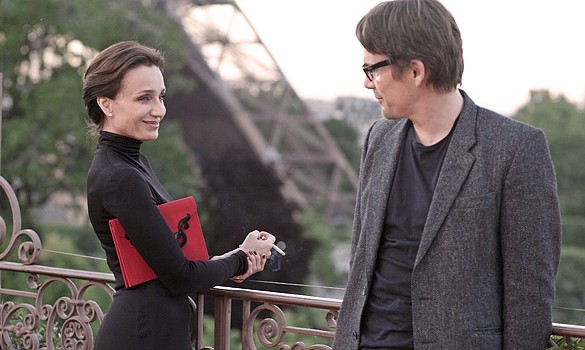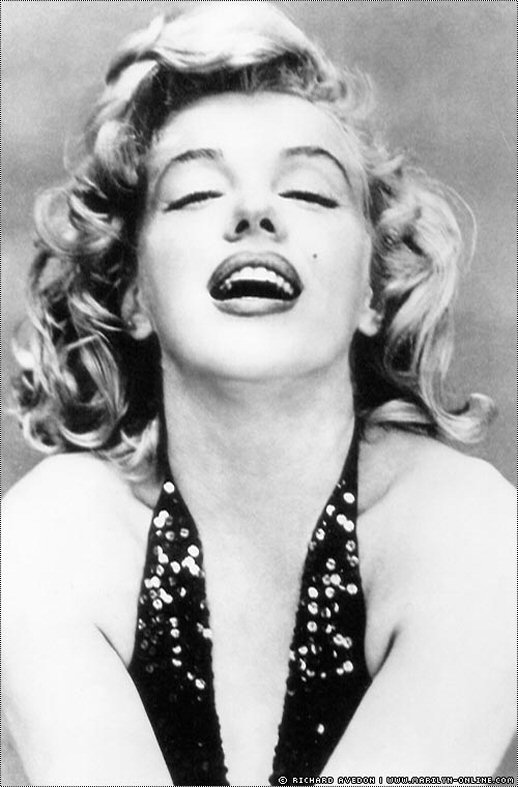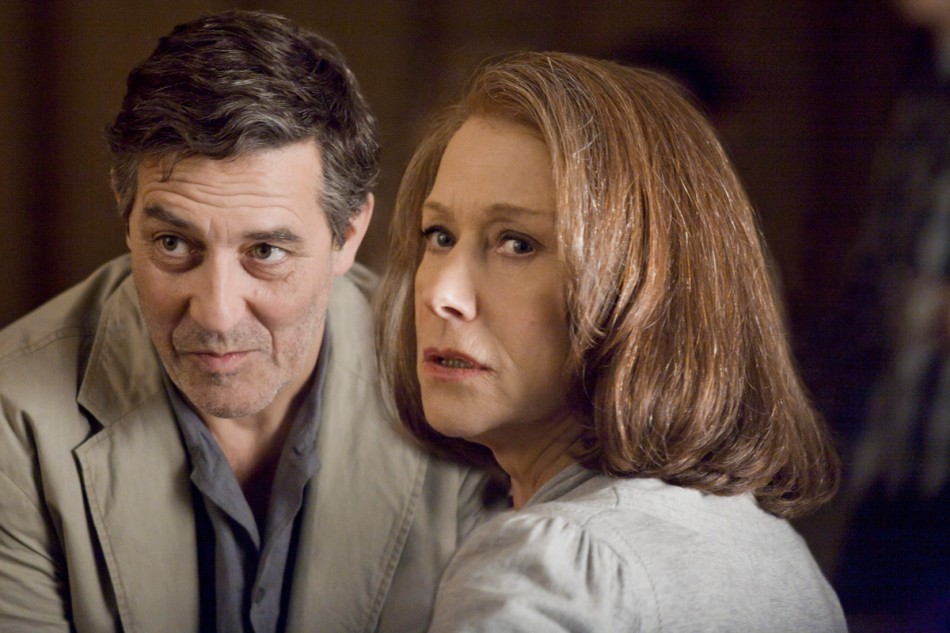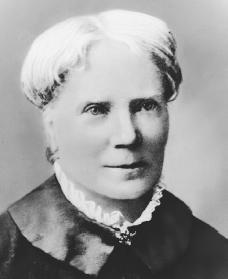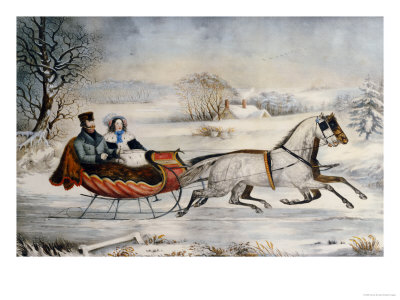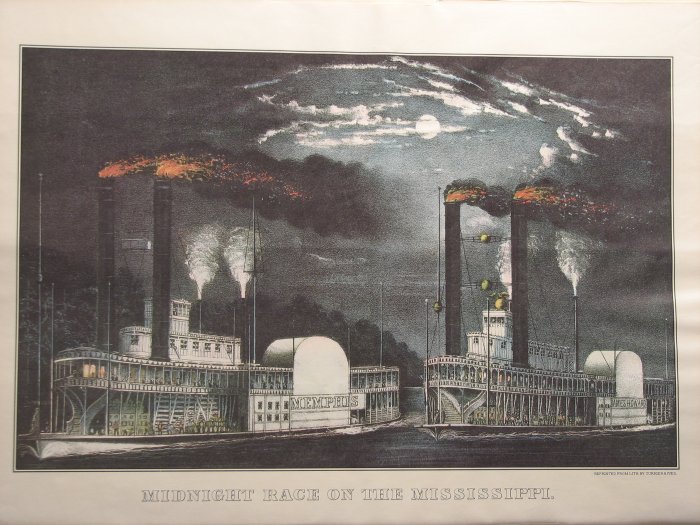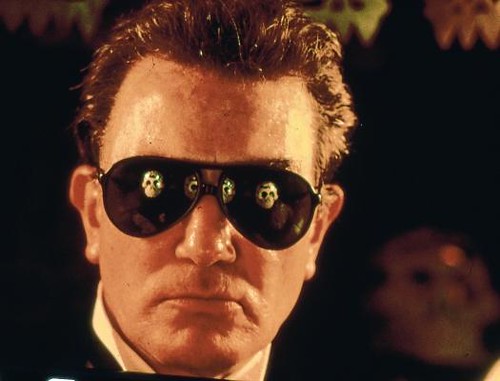Word of the day:
barmy : full of barm, foamy ; eccentric, daft
This has been the first week in Georgia when it hasn't been sunny at least 5 of the 7 days of the week. Tears...
Take Shelter is the kind of film you might want to jump ship from in the first ten minutes, but if you stick with, you'll be rewarded: it has a steadily accumulating power and two great performances.
It's a joke that Michael Shannon wasn't nominated for an Oscar. I'm convinced that a majority of Academy members didn't watch this film. Or is that some think this kind of role comes too easy for Shannon?
Shannon has a twisted countenance, pained, that of a constipated bug with bad thoughts. I mean, the Academy nominated his intense work in
Revolutionary Road and this, if anything, is a longer, more blistering take on psychiatric madness, only more fleshed-out, haunting. I don't know how Shannon is able to sustain and make exciting such inner turmoil, but he does. He plays Curtis, a northeastern Ohio construction worker (the film was shot in 24 days up around Lorain and surrounding counties) who starts having terrifying visions of an approaching storm - well, of
something. His wife (Jessica Chastain) and deaf daughter are at his mercy, dependent on him as the breadwinner. Curtis begins acting very strange: he chains the dog up in the back yard; he urinates in his sleep; he starts building a bomb shelter; he loses his job. In a scene destined to be a classic, he freaks out a local fish fry.
So what's going on? Is he mentally ill, like his mother (Kathy Baker)? Or is something meteorological really coming? Writer-director Jeff Nichols shoots the Ohio landscape ominously, the skies filled with portent, but Nichols is tuned into the national mood too, one of anxiety, suspicion, trepidation. Nichols has a brilliant knack for detail, of specificity of behavior (though I noticed one gaffe that I won't mention), and he doesn't overdo allegory either; this feels like a very specific family, at a very specific place in time. Health care and insurance play a significant role in the story too. Nichols asks: Who can even
afford to be crazy these days?
The tension mounts and mounts, and Curtis' plight more and more resembles our own. We all at times feel as if no one gets us, understands us, that we know something everyone else should and don't. It's a sad story, and the ending is divisive. Some find it appropriate, striking; others hate it. I assumed it was another vision, and. as that, it worked for me.
As good as Shannon's work is, Chastain's is even better. Is there anything this actress can't do? She was terrific in
The Help, a scene stealer, but it doesn't compare to the talent she displays here. She takes something of a second banana role and imbues the part with real integrity. She manages to be compassionate, angry, confused, understanding, scared - sometimes all within the same moment. She's so good here, she makes everyone who has ever played a wife seem one-dimensional. Her reaction to Shannon's outbreak at the fish fry is single-handedly the most moving scene I've seen all year.

What's Your Number? is pretty good too, far better than I thought it would be. Anna Faris excels in the kind of role that's tailor-made for her elastic physical skills and dumb-blonde, oversexed silliness. She plays a recently-fired Boston woman who realizes that she has slept with far too many guys. Her plan is to find one of the guys she bedded in her past and forge a relationship with him - and, hopefully, a marriage. Her partner in the task is her always-hungry musician neighbor (Chris Evans). The film is raunchy but not distractingly, forcedly so. It's genuinely funny, if predictable. The supporting cast - Joel McHale, Chris Pratt, Anthony Mackie, Blythe Danner, Zachary Quinto, Ari Graynor, and Ed Begley Jr. - makes the most of their scenes. There's some zing to the dialogue, particularly between the appealing leads, who have terrific chemistry. It may disappoint some that the film eventually plays out in the old choice between the so-called Mr. Right (here embodied in Dave Annable's boring politico) and The True Love (Evans). Oh, well. I still enjoyed it a lot.
- I'm no longer reading Philip Kerr's
Field Gray, so I won't make any more references to it, as I said that I would during the last post. Too dense. Too many names, ranks, organizations.
- As I also mentioned in my last post, I want to go ahead and focus on one of the Americans abroad in the David McCullough book I'm reading now,
The Greater Journey.
James Fenimore Cooper
(1789-1951)
Author
Time in Paris: 1826-1833
Known for: The most successful novelist American writer of his time (and, arguably for a good century or so), the first successful popular American novelist. Created an indelible character - the leathery, savvy woodsman (the son of white Americans, but raised by Native Americans) Natty Bumppo, the hero of Cooper's five Leatherstocking Tales:
The Deerslayer, The Last of the Mohicans, The Pathfinder, The Pioneers, The Prairie.
Last of the Mohicans is his most famous work.
Why'd he go to Paris: His father (whom the town of Cooperstwon, New York - site of the Baseball Hall of Fame - is named for), a renowned judge, had racked up too much debt and James (whose siblings had largely fell to ruin) was forced to become self-reliant. He had no training as a writer, but, on something of a dare, was urged on by his wife Susan to do so. (According to a story told by his daughter Sue, James was reading aloud to Susan an English novel, which he then threw aside dismissively, saying he could write a better book than that, to which Susan laughed.) Despite beginning his career at the age of 30, he was an immediate success. He was very popular, very well-known when he set out for Paris, his
Last of the Mohicans just being published. His books were all over Paris bookstores.
He went because he thought it would benefit his off-and-on health (he had spleen problems) and he also wanted to improve his children's education.
- He went to Paris with his wife and five children.
- He was revered by other Americans for his American patriotism. Cooper loved America and exemplified the American spirit. He enjoyed the attention he received from Parisians, but he wasn't fond of socialites.
- In one of the works completed by Cooper during his time in France,
Notions of the Americans, Cooper ridicules British and Europeans for their misconceptions of America. It wasn't an attack on American principles or behavior, as was commonly thought. It was a satirical take on how Europeans assumed they knew about Americans, but really didn't.
- He played the flute too!
- Finally, let's talk about the new movies this week as well.
-
Ghost Rider: Spirit of Vengeance What is there to say, really? Nicolas Cage is back. Idris Elba and Ciaran Hands are here, presumably in epic battles with their dignity. Not screened for critics, but there is a lot of Oscar buzz on this one.
-
This Means War Not good reviews for this one, and apparently it's been in development hell for a long time. Whoever was originally slated to star, Reese Witherspoon, Chris Pine, and Tom Hardy now do. Two CIA operatives fall for the same woman. McG directs.
Entertainment Weekly is one of only 28% of critical outlets (as of Thursday noon) that like it, but Roger Ebert calls it an "incompetent stupid action comedy."
-
Thin Ice Sort of
Fargo-meets-
A Simple Plan here, well-reviewed. Who-doesn't-like Greg Kinnear stars as a fumbling Wisconsin insurance agent who tries to bilk a retired farmer (Alan Arkin) out a rare, but highly prized violin. Naturally, Billy Crudup, as Kinnear's hotly-tempered partner, shows up, and everything goes to shit. Directed by Jill Sprecher, who made a pretty good movie with Arkin over a decade ago,
Thirteen Conversations About One Thing.
-
Return It actually opened last week, to blisteringly good reviews. Linda Cardellini, after spending six seasons on
ER, one on the mighty
Freaks and Geeks, and two romps as Velma in the truly detestable
Scooby Doo films, finally finds a role for his talents as a soldier home from Afghanistan, unable to connect with her husband (Michael Shannon!) but befriending a A.A. member/Vietnam vet (hooray for John Slattery), who may or may not be dangerous. Quiet, subtle, kind of slow, familiar in concept to
The Lucky Ones,
Stop-Loss, and the end of
The Hurt Locker, if the film was released at the end of last year, there might be some Oscar nom talk for Cardellini.


